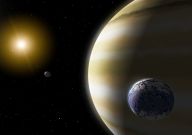
unsolvedmystery- Our solar system is rather unique. It is a spinning disk with the sun in the center, of which is surrounded by four terrestrial - or rocky - planets, an asteroid belt, four gas giants and five dwarf planets. Many other star systems have been discovered, but many just don’t fit the bill for likeness to our own. For one, many of these systems have Hot Jupiters, inner planets the size of - and sometimes larger than - the planet Jupiter.
To occasionally break the rule, scientists have discovered a new star called HP 56948. HP 56948 is remarkably similar to our own sun. It has relatively the same mass as our sun and, as well, it is a G2V (yellow dwarf) sharing chemical composition and temperatures with our sun. It also has planets revolving around it.
However, sharing characteristics with our own sun doesn’t say that the HP 56948 system has planets similar to our Earth that can support life. Many Hot Jupiters revolve around a star very similar to our star (like 51 Pegasi b, also called Bellerophon). Here’s where it gets interesting, though: astronomers have not detected a short-period wobble on HP 56948, meaning that no Hot Jupiter would be that close to the star (If otherwise, its gigantic size would influence its sun to create a wobble).
If there were no (or at least not many) Hot Jupiters revolving around HP 56948, then could there be terrestrial planets? Perhaps even some in the “Goldilocks zone“? The chemical composition of the star suggests so. It has an amount of silicon, magnesium, aluminum and calcium similar to our sun, elements of which are usually found in asteroids, rocky planets and interplanetary dust.
Could HP 56948 have inner system planets similar to our own and beloved planet? If so, could there be intelligent life on one of them? Could this star have formed around the same time as our sun? If so, it would give extraterrestrials the same amount of time as us to evolve. Perhaps they even have evolved to be an intelligent civilization.
HP 56948 is just one of many new exoplanets that possibly hosts life out there and it is a beneficial contribution to astrology and possibly the future of astrobiology.
To occasionally break the rule, scientists have discovered a new star called HP 56948. HP 56948 is remarkably similar to our own sun. It has relatively the same mass as our sun and, as well, it is a G2V (yellow dwarf) sharing chemical composition and temperatures with our sun. It also has planets revolving around it.
However, sharing characteristics with our own sun doesn’t say that the HP 56948 system has planets similar to our Earth that can support life. Many Hot Jupiters revolve around a star very similar to our star (like 51 Pegasi b, also called Bellerophon). Here’s where it gets interesting, though: astronomers have not detected a short-period wobble on HP 56948, meaning that no Hot Jupiter would be that close to the star (If otherwise, its gigantic size would influence its sun to create a wobble).
If there were no (or at least not many) Hot Jupiters revolving around HP 56948, then could there be terrestrial planets? Perhaps even some in the “Goldilocks zone“? The chemical composition of the star suggests so. It has an amount of silicon, magnesium, aluminum and calcium similar to our sun, elements of which are usually found in asteroids, rocky planets and interplanetary dust.
Could HP 56948 have inner system planets similar to our own and beloved planet? If so, could there be intelligent life on one of them? Could this star have formed around the same time as our sun? If so, it would give extraterrestrials the same amount of time as us to evolve. Perhaps they even have evolved to be an intelligent civilization.
HP 56948 is just one of many new exoplanets that possibly hosts life out there and it is a beneficial contribution to astrology and possibly the future of astrobiology.



